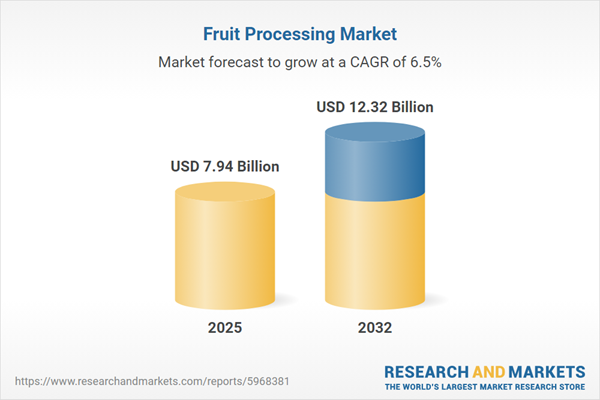Speak directly to the analyst to clarify any post sales queries you may have.
The fruit processing market is experiencing transformation as businesses strive to balance shifting consumer expectations, aggressive sustainability objectives, and rapidly changing compliance standards. Senior decision-makers must adapt their strategies to address mounting operational complexity, evolving demographic trends, and increased demand for transparency and innovation.
Market Snapshot: Fruit Processing Market Size and Growth
The fruit processing market is projected to grow from USD 7.46 billion in 2024 to USD 7.94 billion in 2025, registering a CAGR of 6.47%. By 2032, the market is expected to reach USD 12.32 billion. Consistent expansion is underpinned by heightened consumer preferences for nutritious, shelf-stable fruit-based products that are easy to transport and consume. Companies continue to introduce sustainability-led initiatives and digitalize supply chain operations to maintain resilience despite volatile economic environments, fluctuating demographics, and increasingly sophisticated logistic demands. Industry leaders deploy advanced technology, both for process efficiency and to support growth amid these persistent pressures.
Scope & Segmentation of the Fruit Processing Market
- Product Types: Includes canned fruits, fruit concentrates, dried fruits, frozen products, juices, and purees, catering to consumer demand for longer-lasting, convenient, and additive-free food options.
- Packaging Formats: Utilization of glass containers, cans, PET bottles, cartons, and Tetra Pak ensures product preservation, adapts to a variety of market needs, and supports sustainability through recycling initiatives.
- Distribution Channels: Covers HORECA, e-commerce platforms, convenience stores, specialty retailers, supermarkets, and hypermarkets, helping brands maintain a presence across multiple access points with flexible delivery services.
- Fruit Types: Focus on apples, grapes, mangoes, and oranges enables broad application in packaged foods and foodservice, enhancing market-relevant nutrition and meeting regional consumption preferences.
- End Uses: Fruit processing supports food and beverage manufacturers in creating beverages, snacks, and blended health products, with an emphasis on dependable quality and year-round availability.
- Regions: Analysis spans the Americas, Europe, Middle East & Africa, and Asia-Pacific, each presenting unique consumer behaviors, regulatory frameworks, and supply conditions, encouraging customized development and distribution strategies.
- Leading Companies: Market leaders such as Dole Food Company, Fresh Del Monte Produce, Bonduelle SA, Del Monte Foods, PepsiCo, The Coca-Cola Company, Chiquita Brands International, Ocean Spray Cranberries, Driscoll's, and Welch Foods advance industry standards through investments in quality assurance, innovative processes, and sustainability initiatives.
Key Takeaways: Strategic Insights for Senior Leadership
- Pursuing comprehensive supply chain transparency and clean-label initiatives strengthens regulatory compliance and bolsters strategic partner relationships globally.
- Implementing automation and digital technologies throughout procurement and logistics processes enhances response to supply disruptions, while improving overall operational performance.
- Prioritizing sustainable practices—including responsible water use, smart packaging, and ethical sourcing—reinforces brand reputation and long-term business viability.
- Expanding product lines and innovating packaging configurations enables agile responses to region-specific preferences and demographic changes, supporting greater market alignment.
- Localizing production and supply chain elements facilitates faster regulatory approvals and helps tailor distribution to market requirements in different geographies.
- Building collaborative relationships among growers, technology partners, and logistics providers improves risk management and fortifies stability against market uncertainty.
Tariff Impact: U.S. Tariff Adjustments and Global Supply Chains
Expected shifts in U.S. tariffs are anticipated to heighten import costs for fruit concentrates and pulps, prompting organizations to seek alternate sourcing, refine procurement models, and establish robust regional supplier connections. Participating in industry groups and preparing structured mitigation plans will support resilience amid fluctuating global trade conditions.
Methodology & Data Sources
This assessment draws on peer-reviewed academic research, international trade statistics, executive interviews, and the perspectives of technical experts. Rigorous quantitative modeling and ongoing consultation with industry stakeholders contribute to actionable insights for decision-makers in the fruit processing market.
Why This Report Matters
- Empowers executives to anticipate market transitions, achieve compliance across regulatory contexts, and build adaptive supply infrastructures.
- Guides strategy development by highlighting growth opportunities, bolstering competitive positioning, and identifying risks in evolving segments.
- Delivers practical recommendations for upgrading procurement, optimizing operations, and meeting future consumer and sustainability standards.
Conclusion
This comprehensive report enables leadership to drive sustainable practices, capitalize on technology adoption, and ensure compliance—strengthening resilience and competitiveness amid dynamic market changes.
Additional Product Information:
- Purchase of this report includes 1 year online access with quarterly updates.
- This report can be updated on request. Please contact our Customer Experience team using the Ask a Question widget on our website.
Table of Contents
3. Executive Summary
4. Market Overview
7. Cumulative Impact of Artificial Intelligence 2025
Companies Mentioned
The companies profiled in this Fruit Processing market report include:- Dole Food Company, Inc.
- Fresh Del Monte Produce Inc.
- Bonduelle SA
- Del Monte Foods, Inc.
- PepsiCo, Inc.
- The Coca-Cola Company
- Chiquita Brands International S.à r.l.
- Ocean Spray Cranberries, Inc.
- Driscoll's, Inc.
- Welch Foods Inc.
Table Information
| Report Attribute | Details |
|---|---|
| No. of Pages | 197 |
| Published | November 2025 |
| Forecast Period | 2025 - 2032 |
| Estimated Market Value ( USD | $ 7.94 Billion |
| Forecasted Market Value ( USD | $ 12.32 Billion |
| Compound Annual Growth Rate | 6.4% |
| Regions Covered | Global |
| No. of Companies Mentioned | 11 |









